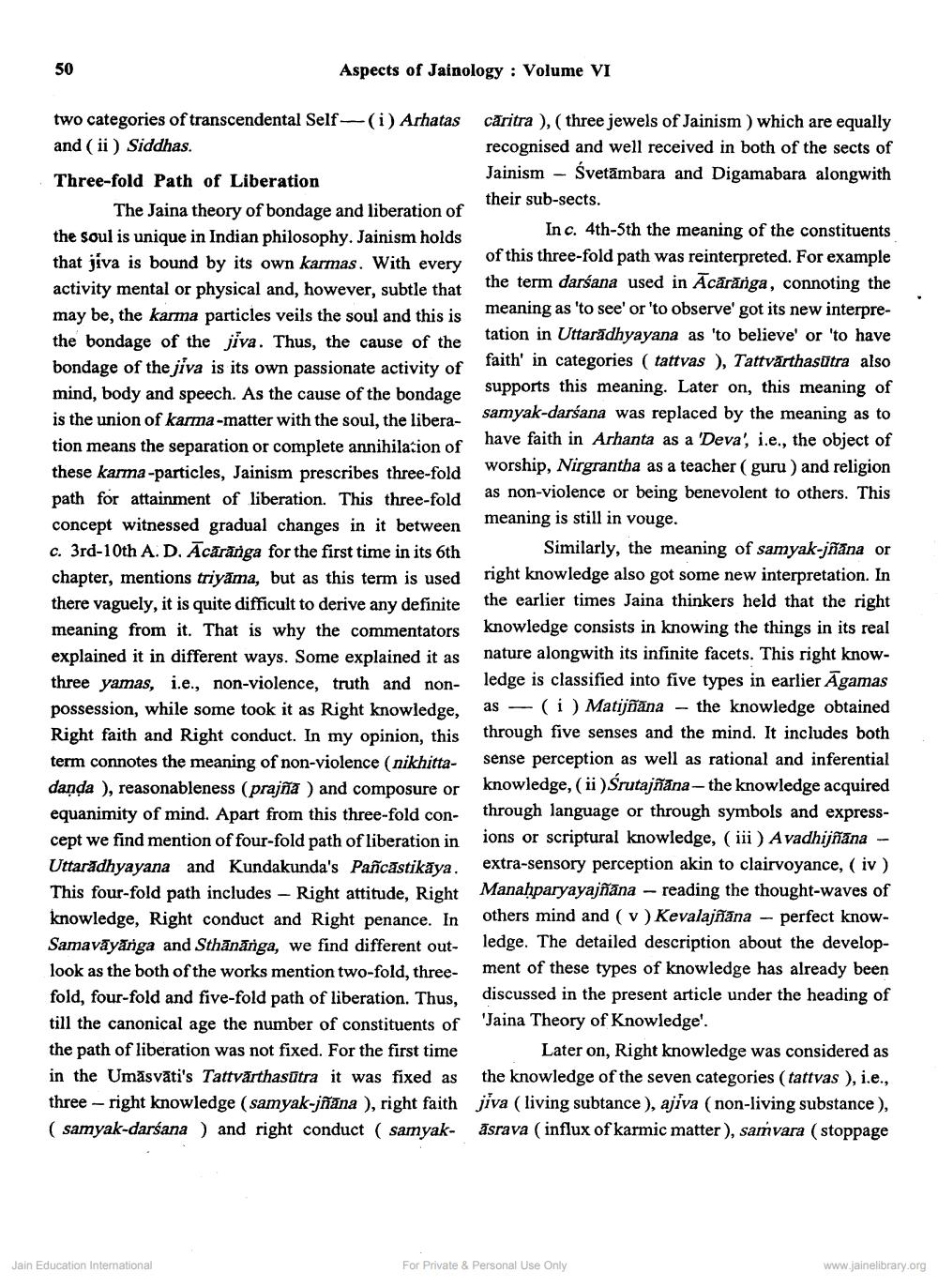________________
50
Aspects of Jainology: Volume VI
two categories of transcendental Self-(i) Arhatas caritra ), ( three jewels of Jainism) which are equally and (ii) Siddhas.
Three-fold Path of Liberation
The Jaina theory of bondage and liberation of the soul is unique in Indian philosophy. Jainism holds that jiva is bound by its own karmas. With every activity mental or physical and, however, subtle that may be, the karma particles veils the soul and this is the bondage of the jiva. Thus, the cause of the bondage of the jiva is its own passionate activity of mind, body and speech. As the cause of the bondage is the union of karma-matter with the soul, the liberation means the separation or complete annihilation of these karma-particles, Jainism prescribes three-fold
path for attainment of liberation. This three-fold concept witnessed gradual changes in it between c. 3rd-10th A. D. Acaranga for the first time in its 6th chapter, mentions triyama, but as this term is used there vaguely, it is quite difficult to derive any definite meaning from it. That is why the commentators explained it in different ways. Some explained it as three yamas, i.e., non-violence, truth and nonpossession, while some took it as Right knowledge, Right faith and Right conduct. In my opinion, this term connotes the meaning of non-violence (nikhitta
danda ), reasonableness (prajña) and composure or equanimity of mind. Apart from this three-fold concept we find mention of four-fold path of liberation in Uttaradhyayana and Kundakunda's Pañcästikäya. This four-fold path includes - Right attitude, Right knowledge, Right conduct and Right penance. In Samavayanga and Sthananga, we find different outlook as the both of the works mention two-fold, threefold, four-fold and five-fold path of liberation. Thus, till the canonical age the number of constituents of the path of liberation was not fixed. For the first time in the Umasvati's Tattvärthasutra it was fixed as three-right knowledge (samyak-jana), right faith (samyak-darśana ) and right conduct (samyak
Jain Education International
recognised and well received in both of the sects of JainismŚvetambara and Digamabara alongwith
their sub-sects.
In c. 4th-5th the meaning of the constituents of this three-fold path was reinterpreted. For example the term darśana used in Acaranga, connoting the meaning as 'to see' or 'to observe' got its new interpretation in Uttaradhyayana as 'to believe' or 'to have faith' in categories (tattvas ), Tattvärthasūtra also supports this meaning. Later on, this meaning of samyak-darśana was replaced by the meaning as to have faith in Arhanta as a 'Deva', i.e., the object of worship, Nirgrantha as a teacher (guru) and religion
as non-violence or being benevolent to others. This meaning is still in vouge.
as
Similarly, the meaning of samyak-jñāna or right knowledge also got some new interpretation. In the earlier times Jaina thinkers held that the right knowledge consists in knowing the things in its real nature alongwith its infinite facets. This right knowledge is classified into five types in earlier Agamas (i) Matijñāna the knowledge obtained through five senses and the mind. It includes both sense perception as well as rational and inferential knowledge, (ii) Śrutajñāna — the knowledge acquired through language or through symbols and expressions or scriptural knowledge, (iii) Avadhijñāna extra-sensory perception akin to clairvoyance, (iv) Manaḥparyayajñāna - reading the thought-waves of others mind and (v) Kevalajñāna perfect knowledge. The detailed description about the development of these types of knowledge has already been discussed in the present article under the heading of 'Jaina Theory of Knowledge'.
-
—
Later on, Right knowledge was considered as the knowledge of the seven categories (tattvas ), i.e., jiva (living subtance), ajiva (non-living substance), asrava (influx of karmic matter), samvara (stoppage
For Private & Personal Use Only
www.jainelibrary.org




